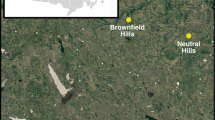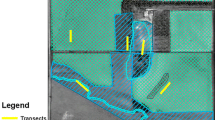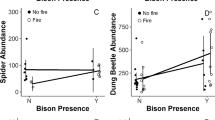Summary
We examined the impact of pocket gopher disturbances on the dynamics of a shortgrass prairie community. Through their burrowing activity, pocket gophers (Thomomys bottae) cast up mounds of soil which both kill existing vegetation and create sites for colonization by competitively-inferior plant species. Three major patterns emerge from these disturbances: First, we show that 10 of the most common herbaceous perennial dicots benefit from pocket gopher disturbance; that is, a greater proportion of seedlings are found in the open space created by pocket gopher disturbance than would be expected based on the availability of disturbed habitat. Additionally, these seedlings exhibited higher growth rates than adjacent seedlings of the same species growing in undisturbed habitat. Second, we tested two predictions of the Intermediate Disturbance Hypothesis and found that species diversity was greatest for plots characterized by disturbances of intermediate age. However, we did not detect significant differences in diversity between plots characterized by intermediate and high levels of disturbance, indicating that many species are adapted to or at least tolerant of high levels of disturbance. Third, we noted that the abundance of grasses decreased with increasing disturbance, while the abundance of dicots increased with increasing disturbance.
Similar content being viewed by others
References
Aldous CM (1951) The feeding habits of pocket gophers (Thomomys talpoides moorei) in the high mountain ranges of central Utah. J Mammal 32:84–88
Anderson DC (1987) Below-ground herbivory in natural communities: a review emphasizing fossorial animals. Q Rev Biol 62:261–286
Anderson DC, McMahon JA (1981) Population dynamics and bioenergetics of a fossorial herbivore. Thomomys talpoides (Rodentia: Geomyidae), in a spruce-fir sere. Ecol Monogr 51:179–202
Armesto JJ, Pickett STA (1985) Experiments on disturbance in old-field plant communities: impacts on species richness and abundance. Ecology 66:230–240
Blais JA (1954) The recurrence of spruce budworm infestations in the past century in the Lac Seul area of northwestern Ontario. Ecology 35:62–71
Cantor LF, Whitham TG (1989) Importance of belowground herbivory: pocket gophers may limit aspen to rock outcrop refugia. Ecology 70:962–970
Connell JH (1978) Diversity in tropical rain forests and coral reefs. Science 199:1302–1310
Coppock DL, Detling JK, Ellis JE, Dyer MI (1984) Plant-herbivore interactions in a North American mixed-grass prairie I. Effects of black-tailed prairie dogs on intraseasonal aboveground plant biomass and nutrient dynamics and plant species diversity. Oecologia 56:1–9
Dayton PK (1971) Competition, disturbance and community organization: the provision and subsequent utilization of space in a rocky intertidal community. Ecol Monogr 41:351–389
Denslow JS (1980) Patterns of plant species diversity during succession under different disturbance regimes. Oecologia 46:18–21
Denslow JS (1984) Disturbance-mediated coexistence of species. In: Pickett STA, White PS (eds) The Ecology of Natural Disturbance and Patch Dynamics, pp 307–323. Academic Press, New York
Ellison L, Aldous CM (1952) Influence of pocket gophers on vegetation of subalpine grassland in central Utah. Ecology 33:177–186
Foster MA, Stubbendieck J (1980) Effects of the plains pocket gopher (Geomys bursarius) on rangeland. J Range Manage 33:74–78
Gettinger RD (1984) Energy and water metabolism of free-ranging pocket gophers, Thomomys bottae. Ecology 65:740–751
Ghent AW, Fraser DA, Thomas JB (1957) Studies of forest stands devastated by the spruce budworm I. For Sci 3:184–208
Grant WE, French NR, Folse LJ Jr (1980) Effects of pocket gopher mounds on plant production in shortgrass prairie ecosystems. Southwest Nat 25:215–224
Grime JP (1977) Evidence for the existence of three primary strategies in plants and its relevance to ecological and evolutionary theory. Am Natur 111:1169–1194
Grubb PJ (1977) The maintenance of species richness in plant communities: the importance of the regeneration niche. Biol Rev 52:107–145
Hanes TL (1971) Succession after fire in the chaparral of southern California. Ecol Monogr 41:27–52
Harper JL (1977) Population Biology of Plants. Academic Press, London
Hartshorn GS (1978) Tree falls and tropical forest dynamics. In: Tomlinson PB, Zimmerman MH (eds) Tropical Trees as Living Systems. Cambridge University Press, Cambridge, pp 617–638
Hobbs RJ, Mooney HA (1985) Community and population dynamics of serpentine grassland annuals in relation to gopher disturbance. Oecologia 67:342–351
Hobbs RJ, Gulmon SL, Hoobs VJ, Mooney HA (1988) Effects of fertiliser addition and subsequent gopher disturbance on a serpentine annual grassland community. Oecologia 75:291–295
Hubbell SP (1979) Tree dispersion, abundance, and diversity in a tropical dry forest. Science 203:1299–1309
Huston M (1979) A general hypothesis of species diversity. Am Natur 113:81–101
Inouye RS, Huntley NJ, Tilman D, Tester JR (1987) Pocket gophers (Geomys bursarius), vegetation, and soil nitrogen along a successional sere in east central Minnesota. Oecologia 72:178–184
Laycock WA (1958) The initial pattern of revegetation of pocket gopher mounds. Ecology 39:346–351
Laycock WA, Richardson BZ (1975) Long term effects of pocket gopher control on vegetation and soils of a subalpine grassland. J Range Manage 28:458–462
Loucks OL (1970) Evolution of diversity, efficiency, and community stability. Am Zool 10:17–25
Loucks OL, Plumb-Mentjes ML, Rogers D (1984) Gap processes and large-scale disturbances in sand prairies. In: Pickett STA, White PS (eds) The Ecology of Natural Disturbance and Patch Dynamics. Academic Press, New York, pp 71–83
Lubchenco J (1978) Plant species diversity in a marine intertidal community: importance of herbivore food preference and algal competitive abilities. Am Natur 112:23–39
MacArthur RH (1972) Geographical Ecology. Harper and Row, New York
McDonough WT (1974) Revegetation of gopher mounds on aspen range in Utah. Great Basin Nat 34:267–274
Paine RT (1966) Food web complexity and species diversity. Am Nat 100:65–75
Paine RT, Levin SA (1981) Intertidal landscapes: disturbance and the dynamics of pattern. Ecol Monogr 51:145–178
Pickett STA (1980) Non-equilibrium coexistence of plants. Bull Torr Bot Club 107:238–248
Platt WJ (1975) The colonization and formation of equilibrium plant species associations on badger disturbances in a tall grass prairie. Ecol Monogr 45:285–305
Reichman OJ (1988) Comparison of the effects of crowding and pocket gopher disturbance on mortality, growth, and seed production of Berteroa incana. Am Midl Nat 120:58–69
Reichman OJ, Smith CS (1985) Impact of pocket gopher burrows on overlying vegetation. J Mammal 66:720–725
Schoener TW (1974) Resource partitioning in ecological communities. Science 185:27–39
Sousa WP (1979) Disturbance in marine intertidal boulder fields: the nonequilibrium maintenance of species diversity. Ecology 60:1225–1239
Sousa WP (1984) The role of disturbance in natural communities. Ann Rev Ecol Syst 15:353–391
Spencer SR, Cameron GN, Eshelman BD, Cooper LC, Williams LR (1985) Influence of pocket gopher mounds on a Texas coastal prairie. Oecologia 66:111–115
Tilman D (1982) Resource Competition and Community Structure. Princeton University Press, Princeton, New Jersey
Tilman D (1983) Plant succession and gopher disturbance along an experimental gradient. Oecologia 60:285–292
Turner GT (1969) Responses of mountain grassland to gopher control, reduced grazing, and herbicide. J Range Manage 22:377–383
Vaughan TA (1967) Food habitats of the northern pocket gopher on shortgrass prairie. Am Midl Nat 77:176–189
Ward AL, Keith JO (1962) Feeding habits of pocket gophers on mountain grasslands, Black Mesa, Colorado. Ecology 43:744–749
White PS (1979) Pattern, process, and natural disturbance in vegetation. Bot Rev 45:229–299
Williams LR, Cameron GN (1986) Effects of removal of pocket gophers on a Texas coastal prairie. Am Midl Natur 115:216–224
Williams LR, Cameron GN, Spencer SR, Eshelman BD, Gregory MJ (1986) Experimental analysis of the effects of pocket gopher mounds on a Texas coastal prairie. J Mammal 67:672–679
Wright HE (1974) Landscape development, forest fires, and wildlife management. Science 186:487–495
Zar JH (1984) Biostatistical Analysis. Prentice Hall, Englewood Cliffs
Author information
Authors and Affiliations
Rights and permissions
About this article
Cite this article
Martinsen, G.D., Cushman, J.H. & Whitham, T.G. Impact of pocket gopher disturbance on plant species diversity in a shortgrass prairie community. Oecologia 83, 132–138 (1990). https://doi.org/10.1007/BF00324644
Received:
Accepted:
Issue Date:
DOI: https://doi.org/10.1007/BF00324644




